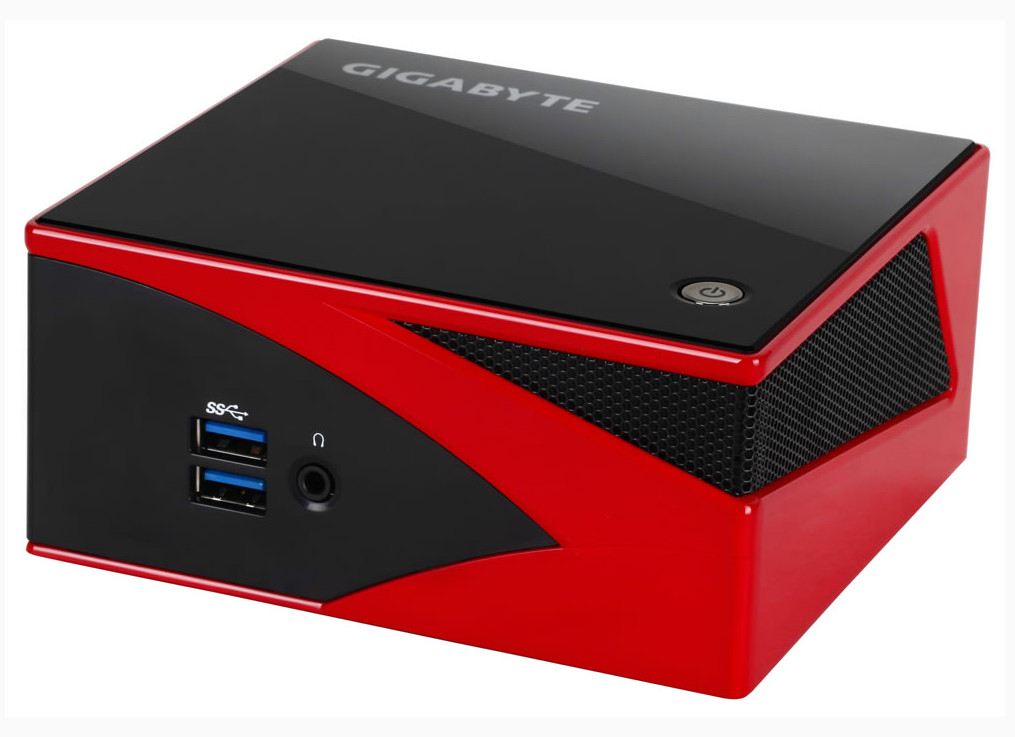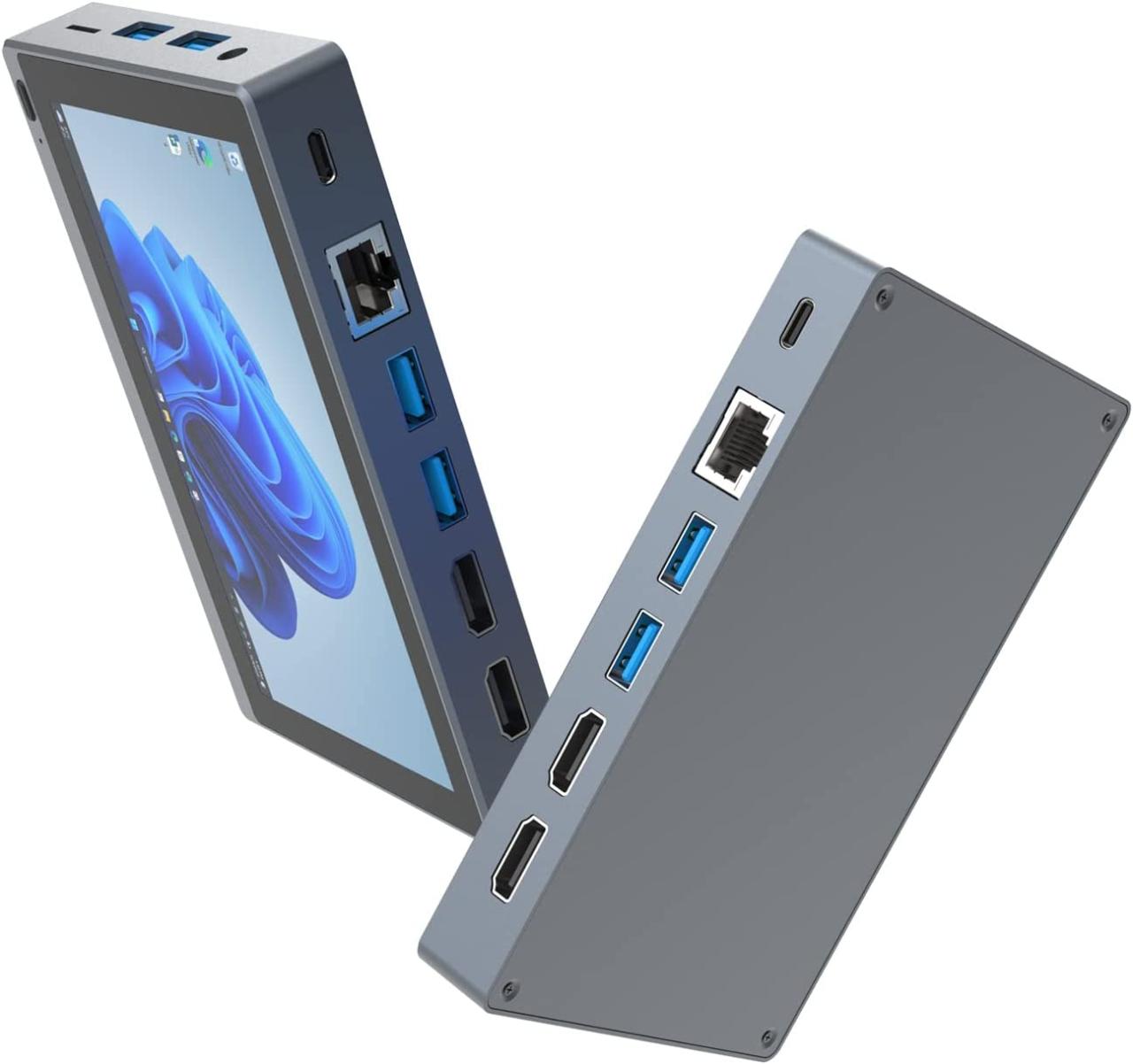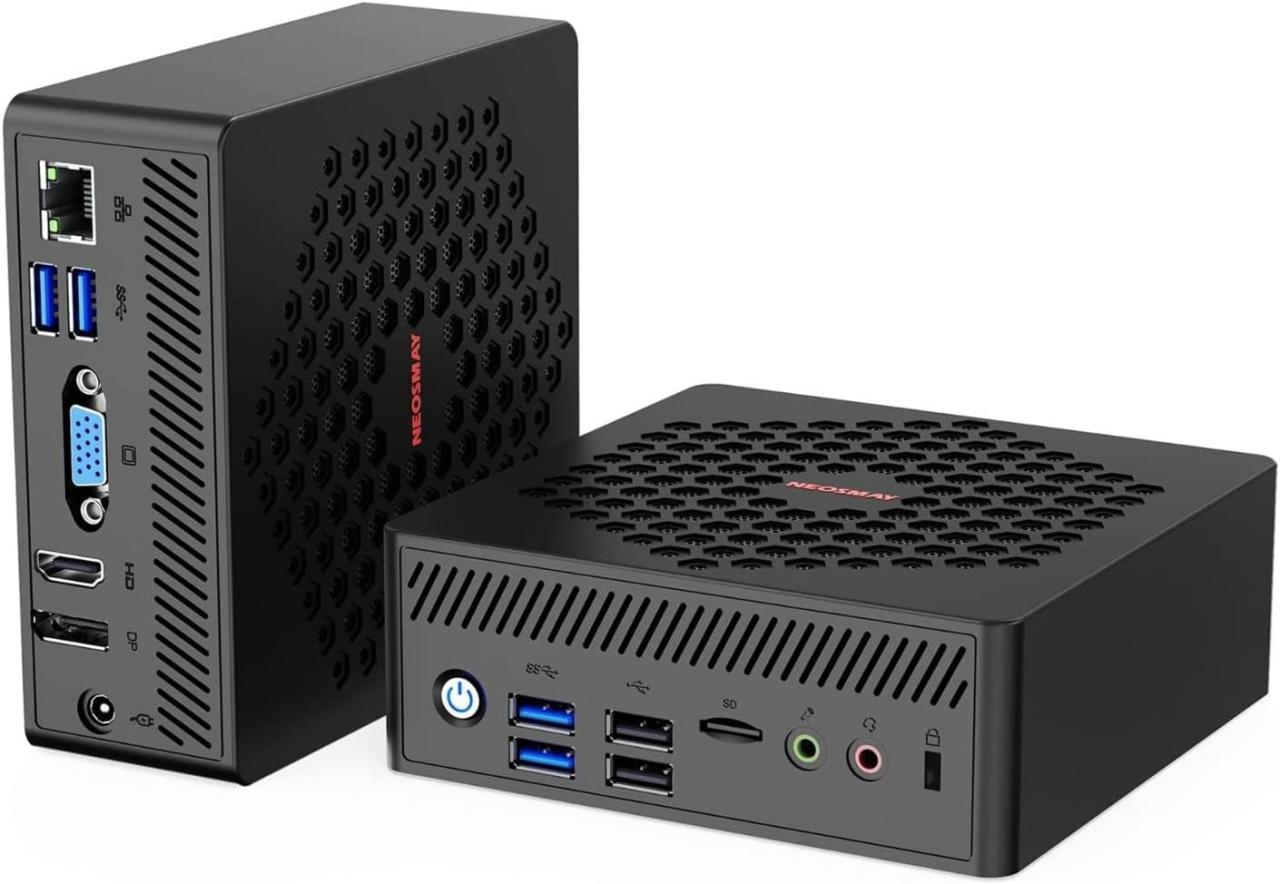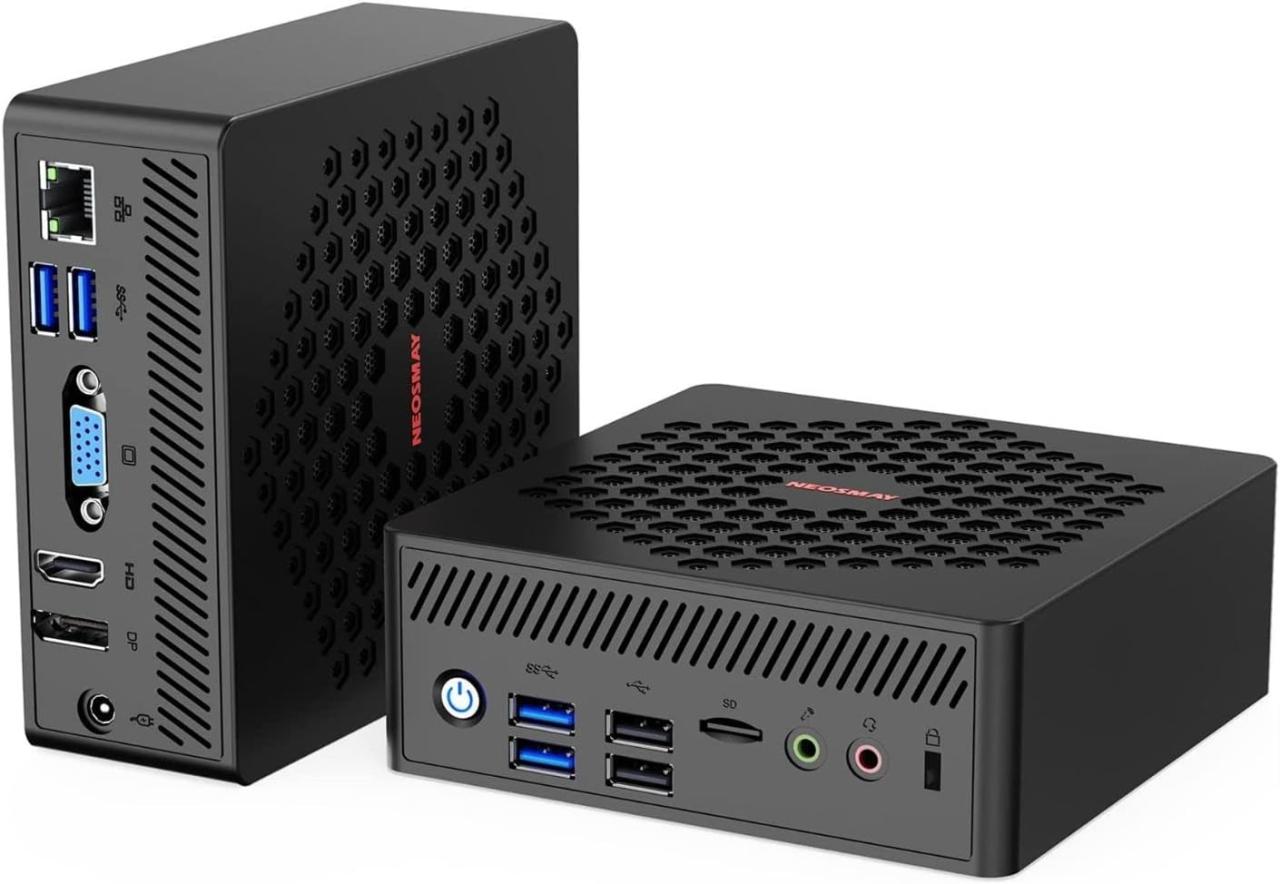The mini PC market is booming, offering powerful performance in a compact form factor. This guide delves into the world of best mini PCs, exploring everything from key features and considerations to top brands, use cases, and future trends. We’ll dissect the technical specifications that impact performance, and provide insights into troubleshooting and maintenance.
From budget-friendly options to high-end configurations, we’ll help you navigate the diverse choices available and select the perfect mini PC for your needs, whether you’re a casual user, a power user, or someone seeking a versatile machine for multiple tasks.
Overview of Mini PCs
Mini PCs are compact, powerful alternatives to traditional desktops. They offer a compelling blend of performance and space-saving design, making them ideal for various applications. Their smaller form factor allows them to fit seamlessly into any environment, from home offices to professional settings.These systems deliver desktop-grade performance in a remarkably small package. The key advantages often outweigh the perceived compromises compared to larger desktop systems.
Understanding their characteristics and features is crucial to making informed purchasing decisions.
Definition of a Mini PC
A mini PC is a small-scale computer system designed for desktop-level performance. It typically integrates the essential components of a traditional desktop, including a processor, memory, storage, and input/output interfaces, into a compact chassis. Mini PCs prioritize space efficiency without sacrificing functionality. Their compact size distinguishes them from standard desktop computers, and their design allows them to seamlessly integrate into various environments.
Key Features and Benefits
Mini PCs offer several advantages over traditional desktops. Their compact size is a primary benefit, maximizing available space and promoting aesthetic appeal in modern setups. They are usually energy-efficient, often consuming less power compared to their desktop counterparts. The reduced size and weight make them easily portable for mobile use. Quiet operation, a crucial feature, contributes to a comfortable and undisturbed working environment.
Mini PCs are increasingly becoming an integral part of smart home automation and multimedia systems, thanks to their versatility and affordability.
Comparison of Form Factors
Mini PCs come in various form factors, each catering to specific needs and aesthetics. The most common form factors include the desktop-style mini PC, the slimline or all-in-one models, and the rackmount versions. The desktop-style mini PCs offer a wide range of connectivity options. Slimline models prioritize aesthetics and portability. Rackmount versions are ideal for server rooms or environments requiring high density.
Each form factor prioritizes a unique aspect of the user experience.
Typical Specifications
This table Artikels the typical specifications commonly found in mini PCs:
| Component | Typical Specification |
|---|---|
| Processor | Intel Core i3, i5, i7, or AMD Ryzen 3, 5, 7 series |
| RAM | 8GB to 32GB DDR4 or DDR5 |
| Storage | 256GB to 2TB SSD or HDD |
| Graphics | Integrated graphics or dedicated graphics card (e.g., NVIDIA GeForce) |
| Connectivity | Wi-Fi, Bluetooth, Gigabit Ethernet, USB ports |
The table illustrates the common range of specifications that are prevalent in mini PCs. This provides a snapshot of the current technological capabilities of mini PCs, ranging from entry-level to high-end systems. These specifications reflect the evolving technology and consumer demands in the market.
Key Considerations for Purchase

Choosing the right mini PC hinges on understanding your needs and the available options. Factors like processing power, graphics capabilities, memory, and storage capacity all play a crucial role in determining the ideal mini PC for a specific task or use case. This section delves into the key elements to consider when making a purchase.
Processor Speed and Graphics Capabilities
The processor, often referred to as the CPU, is the brain of the mini PC. Its speed and architecture directly impact performance, particularly in demanding applications. High-end processors are crucial for tasks like video editing, 3D modeling, or running multiple applications simultaneously. Likewise, the graphics processing unit (GPU) is essential for tasks requiring visual processing, such as gaming or video playback.
A dedicated GPU, especially one with advanced features, significantly enhances the mini PC’s ability to handle graphical workloads. The selection of processor and GPU depends on the intended use case. For basic office tasks or web browsing, a less powerful configuration may suffice. However, more demanding applications, such as video editing or 3D rendering, necessitate a more powerful processor and a capable GPU.
RAM and Storage Capacity
RAM, or random access memory, dictates how many programs and data the mini PC can hold in active use. More RAM allows for smoother multitasking and more efficient program operation. Storage capacity, typically measured in gigabytes (GB) or terabytes (TB), is the space available for storing files and programs. For a home office setup, 8GB of RAM and 256GB of storage may be sufficient.
However, users who frequently handle large files or require extensive multitasking may benefit from 16GB of RAM and 512GB of storage or more. The choice of storage type (e.g., SSD vs. HDD) also influences performance. Solid-state drives (SSDs) offer significantly faster read and write speeds compared to hard disk drives (HDDs), resulting in quicker loading times and a more responsive experience.
Use Cases and Price Ranges
Mini PCs cater to diverse needs. For a home office, a mini PC with a balanced processor, sufficient RAM, and ample storage is ideal. A media center setup may prioritize a powerful processor and a dedicated GPU for high-quality video playback and streaming. Gaming mini PCs need high-end processors, powerful GPUs, and ample RAM to support the demands of modern games.
Price ranges for mini PCs vary greatly, reflecting the diverse components and features. Budget-friendly options often compromise on features, while premium mini PCs offer the most powerful processors, GPUs, and extensive memory. For instance, a basic mini PC for light use might cost around $200-$350, while a high-end gaming mini PC could cost upwards of $1000. This wide range in pricing enables users to choose a mini PC that aligns with their budget and requirements.
Comparison with Other Alternatives
| Feature | Mini PC | Laptop | Desktop ||——————-|——————————————|——————————————-|——————————————|| Size | Compact and space-saving | Portable, but larger than a mini PC | Larger and takes up more space || Portability | Less portable than a laptop | Highly portable | Least portable || Performance | Varies based on configuration | Generally balanced for everyday tasks | High performance, customizable || Expandability | Limited expansion options | More expansion options | Significant expansion options || Cost | Typically more affordable than comparable laptops or desktops | Typically more expensive than a mini PC but cheaper than a desktop.
| Typically most expensive |
Use Cases and Recommendations
Mini PCs offer a compelling blend of portability, performance, and affordability, making them suitable for a wide array of tasks. Their compact form factor and efficient energy consumption are especially attractive for users seeking a versatile and space-saving computing solution. Understanding the specific use case allows for tailored recommendations, maximizing the mini PC’s potential for different needs and budgets.Choosing the right configuration is crucial for optimal performance.
Factors such as processor speed, RAM capacity, and storage space directly impact the mini PC’s ability to handle demanding applications. Considering the workload associated with the intended tasks is vital in selecting the most suitable model.
Video Editing
Video editing tasks, ranging from basic to professional-grade projects, benefit significantly from a mini PC. A powerful processor and ample RAM are essential to handle video encoding and editing software smoothly. Solid-state drives (SSDs) offer significantly faster load times, improving workflow efficiency.
- Recommended Configuration: A mini PC with a high-end processor (e.g., Intel Core i5-13th generation or AMD Ryzen 7), 16GB or more of RAM, and a fast NVMe SSD (512GB or larger) will provide a responsive and efficient video editing experience.
- Example Mini PC (Budget-Friendly): A mini PC with an Intel Core i5-11th generation, 8GB RAM, and 256GB SSD is suitable for light video editing tasks but might experience slowdowns with large projects.
3D Rendering
Mini PCs are increasingly capable of handling 3D rendering tasks, although the configuration needs to be carefully selected. Modern mini PCs often include powerful graphics processors (GPUs) integrated into the CPU, enhancing their 3D rendering capabilities. RAM and storage space are critical for smooth operation.
- Recommended Configuration: For demanding 3D rendering, a mini PC with a high-end processor (e.g., Intel Core i7-13th generation or AMD Ryzen 9), 16GB or more of RAM, a fast NVMe SSD (1TB or larger), and an integrated GPU capable of handling the specific software is recommended. The integrated GPU may not suffice for very demanding tasks; a dedicated graphics card may be necessary.
Light Gaming
Casual gaming can be enjoyed on mini PCs, especially with titles that don’t demand high graphical fidelity. A balance between processing power and graphical capabilities is key.
- Recommended Configuration: A mini PC with a mid-range processor (e.g., Intel Core i5-12th generation or AMD Ryzen 5), 8GB or more of RAM, and a fast NVMe SSD (256GB or larger) is sufficient for playing less demanding games.
- Example Mini PC (Mid-Range): A mini PC with a mid-range processor, 16GB of RAM, and a 512GB NVMe SSD provides a smoother gaming experience.
Table of Recommendations
| Use Case | Processor | RAM | Storage | GPU | Budget (Approximate) |
|---|---|---|---|---|---|
| Light Video Editing | Intel Core i5-11th Gen or AMD Ryzen 5 | 8GB | 256GB SSD | Integrated | $250-$400 |
| Professional Video Editing | Intel Core i7-13th Gen or AMD Ryzen 7 | 16GB+ | 512GB+ NVMe SSD | Integrated (or dedicated GPU) | $400-$800+ |
| 3D Rendering (Basic) | Intel Core i5-13th Gen or AMD Ryzen 5 | 16GB+ | 1TB+ NVMe SSD | Integrated | $400-$600 |
| 3D Rendering (Advanced) | Intel Core i7-13th Gen or AMD Ryzen 7 | 32GB+ | 2TB+ NVMe SSD | Integrated (or dedicated GPU) | $600-$1000+ |
| Light Gaming | Intel Core i5-12th Gen or AMD Ryzen 5 | 8GB+ | 256GB+ NVMe SSD | Integrated | $200-$400 |
Technical Specifications and Performance
Choosing the right mini PC hinges on understanding its inner workings. Performance is dictated by a complex interplay of components, each contributing to the overall experience. From the processor’s architecture to the cooling system, every detail influences how quickly and smoothly the mini PC operates.
Processor Architectures
Different processor architectures, primarily from Intel and AMD, significantly impact mini PC performance. Intel processors, known for their established track record, often prioritize efficiency and reliability. AMD processors, on the other hand, are frequently favored for their balance of performance and cost-effectiveness. The specific model of processor, its number of cores and threads, and its clock speed all directly affect the mini PC’s ability to handle tasks efficiently.
For example, a mini PC with a powerful processor like the Intel Core i7 can handle complex tasks like video editing and 3D rendering smoothly, while a less powerful processor might struggle.
RAM and Storage Capacity
The amount of RAM (Random Access Memory) and storage capacity directly influence the mini PC’s ability to handle multiple applications and large files simultaneously. More RAM allows for running more programs and multitasking without experiencing slowdowns. Similarly, larger storage drives allow for storing more data and programs. For instance, a mini PC with 16GB of RAM and a 512GB SSD will likely perform better with multitasking and demanding applications than one with 8GB of RAM and a 256GB HDD.
The speed of the storage drive, whether an SSD or HDD, also plays a crucial role.
Graphics Cards
Graphics cards, or GPUs, are essential for tasks requiring significant graphical processing, such as gaming, video editing, and 3D modeling. Integrated graphics, often found in budget-friendly mini PCs, are sufficient for basic tasks like web browsing and office work. However, dedicated graphics cards offer significantly enhanced performance for demanding applications. For instance, a mini PC with a dedicated Nvidia GeForce graphics card can provide smoother gaming and better visual quality than a mini PC with integrated graphics.
Connectivity Options
The type of connectivity options available, including Wi-Fi and Ethernet, directly affect the speed and reliability of network connections. Ethernet provides a faster and more stable connection compared to Wi-Fi, especially for demanding tasks like video streaming or online gaming. The Wi-Fi standard (e.g., Wi-Fi 6) also influences the connection speed and range. For instance, a mini PC with a Gigabit Ethernet port will deliver much faster download and upload speeds compared to one relying solely on Wi-Fi.
Cooling Systems
Efficient cooling systems are crucial for ensuring the longevity and performance of mini PCs. Overheating can lead to performance degradation and potential damage to components. Mini PCs with robust cooling solutions, such as large heatsinks and advanced fans, can maintain optimal temperatures during demanding tasks. A mini PC with inadequate cooling might struggle with demanding tasks, causing performance to drop and potentially leading to component failure over time.
Benchmarking
| Mini PC Model | Processor | RAM (GB) | Storage | Graphics | Average Score (Video Editing) | Average Score (Gaming) |
|---|---|---|---|---|---|---|
| Model A | Intel Core i5 | 8 | 512GB SSD | Integrated | 75 | 60 |
| Model B | AMD Ryzen 5 | 16 | 1TB SSD | Dedicated Nvidia | 90 | 85 |
| Model C | Intel Core i7 | 16 | 1TB SSD | Dedicated AMD | 95 | 90 |
The table above provides a simplified representation of benchmark scores for video editing and gaming tasks. These scores are averages and may vary based on specific test conditions and software versions. These are illustrative examples and actual scores may differ based on specific models and configurations.
Future Trends in Mini PCs
Mini PCs are experiencing a period of rapid evolution, driven by advancements in several key technologies. Their compact form factors, coupled with increasing processing power and specialized capabilities, position them for continued growth in diverse sectors. This section delves into the emerging trends shaping the future of mini PCs.The integration of emerging technologies like artificial intelligence (AI) and machine learning (ML) is significantly impacting mini PC development.
These technologies are driving the creation of more powerful and specialized mini PCs, enabling them to handle complex tasks and applications that were previously beyond their capabilities.
Emerging Technologies Influencing Mini PC Development
Mini PCs are evolving to incorporate cutting-edge technologies, like AI and machine learning. These advancements enable mini PCs to tackle complex computational tasks more efficiently. This includes tasks such as image recognition, natural language processing, and predictive modeling. These advancements translate to mini PCs that are better equipped to support applications requiring powerful processing capabilities.
Potential Future Mini PC Features
The future holds exciting possibilities for enhanced mini PC features. Improved energy efficiency, compact designs, and expanded connectivity options are expected. The rise of AI and machine learning will likely lead to mini PCs incorporating dedicated AI processing units, allowing for specialized AI workloads. Moreover, enhanced graphics processing capabilities, supporting virtual reality (VR) and augmented reality (AR) applications, will be a notable addition.
Potential for Mini PCs in Specialized Industries
Mini PCs are poised to play a significant role in several specialized industries. In the healthcare sector, they can facilitate remote patient monitoring and diagnostics. In the educational sector, mini PCs can provide powerful tools for interactive learning and multimedia presentations. Furthermore, mini PCs are anticipated to empower small businesses with efficient and affordable computing solutions.
Predicted Trends for the Mini PC Market
The mini PC market is expected to continue its growth trajectory, driven by the increasing demand for compact, powerful, and versatile computing solutions. Mini PCs are predicted to become increasingly versatile, adaptable to a wider range of applications, and feature more sophisticated functionalities. Specialized mini PCs tailored to particular industries are anticipated to emerge, further fueling market growth.
This will be particularly true for AI-focused applications, demanding dedicated processing power.
Table of Future Potential Mini PC Features
| Feature | Description |
|---|---|
| AI Processing Units | Dedicated hardware acceleration for AI tasks like image recognition and natural language processing. |
| Enhanced Graphics | Improved graphics capabilities to support VR/AR applications and high-resolution displays. |
| Advanced Connectivity | Support for next-generation networking protocols and expanded Wi-Fi/Bluetooth options. |
| Specialized Industry Options | Custom configurations for specific industries (e.g., healthcare, education, manufacturing) |
| Improved Energy Efficiency | Reduced power consumption without compromising performance. |
| Compact Form Factors | Smaller designs with improved cooling solutions. |
Troubleshooting and Maintenance

Mini PCs, while compact and powerful, require some attention to ensure optimal performance and longevity. Proper troubleshooting and preventative maintenance are key to maximizing their lifespan and avoiding costly repairs. Understanding common issues and implementing proactive maintenance strategies will help you get the most out of your mini PC investment.
Common Troubleshooting Steps
Troubleshooting a mini PC often begins with the basics. Isolate the problem by systematically checking connectivity, power supply, and software interactions. If the mini PC isn’t powering on, first verify the power cord is securely plugged in and the outlet is functioning. If the mini PC powers on but displays no signal, ensure the video cable is correctly connected to both the mini PC and the display.
Check the display’s power and ensure it’s properly configured to receive the signal. If these steps are unsuccessful, review the mini PC’s operating system logs for error messages. These messages can offer valuable clues to the source of the problem.
Preventative Maintenance Strategies
Regular preventative maintenance is crucial for maintaining the health of your mini PC. Dust accumulation is a major concern. Regularly cleaning the cooling vents and internal components can significantly improve performance and prevent overheating. Avoid using harsh chemicals or excessive force when cleaning. Keep the mini PC’s operating environment clean and well-ventilated to prevent dust buildup.
Importance of Proper Cooling and Airflow
Adequate cooling is essential for the longevity and performance of mini PCs. Overheating can lead to system instability, reduced performance, and even permanent damage. Ensure proper airflow around the mini PC’s cooling vents to prevent heat buildup. Keep the surrounding area clear of obstructions and ensure the mini PC is placed on a stable surface. Consider using a cooling pad or stand if the mini PC is placed in a location with limited airflow.
Installing and Configuring Peripherals
Connecting peripherals to a mini PC is typically straightforward. Ensure the peripherals are compatible with the mini PC’s specifications. For example, a USB keyboard and mouse should be easily recognizable and function without issues. Ensure drivers for the peripheral are installed correctly. Check the mini PC’s operating system documentation for specific instructions on installing drivers.
Troubleshooting Flow Chart Example
| Symptom | Possible Cause | Troubleshooting Steps |
|---|---|---|
| Mini PC not powering on | Power cord issue, power outlet problem | Check power cord connections, try another outlet |
| No display output | Video cable issue, display problem | Check video cable connections, ensure display is powered and configured correctly |
| Slow performance | Insufficient cooling, software conflicts | Check for dust buildup, run system diagnostics, check for outdated drivers |
Outcome Summary

In conclusion, choosing the best mini PC hinges on careful consideration of your specific needs and budget. This guide has explored the various facets of mini PCs, equipping you with the knowledge to make an informed decision. From understanding different form factors to evaluating performance benchmarks, we’ve provided a comprehensive overview to empower you to find the perfect match for your tasks and lifestyle.
The future of mini PCs looks promising, with emerging technologies driving innovation, making them a compelling alternative to traditional desktops and laptops.
FAQ Explained
What are the typical RAM capacities found in mini PCs?
Mini PCs typically offer RAM capacities ranging from 8GB to 64GB, with options for upgrades in some models. The optimal amount depends on your workload; for general use, 8GB to 16GB is sufficient, while more demanding tasks like video editing or gaming may require 32GB or higher.
How do I choose a mini PC for video editing?
For video editing, a mini PC with a powerful processor (like Intel Core i7 or AMD Ryzen 7), ample RAM (32GB or more), a dedicated graphics card (if needed), and fast storage (SSD) is recommended. Consider benchmarks for video editing tasks to assess performance.
What are the common troubleshooting steps for a mini PC that won’t boot?
First, check the power supply and connections. Ensure the power cord is securely plugged in, and the mini PC is properly connected to the power source. If the issue persists, verify the hard drive and RAM are properly installed. If these steps don’t resolve the issue, consult the manufacturer’s support documentation or contact customer support.
What are the different form factors available for mini PCs?
Mini PCs come in various form factors, including SFF (small form factor), mini-ITX, and others. Each form factor impacts the size and number of components that can be housed, and therefore the performance capabilities. SFF is the most common type.






